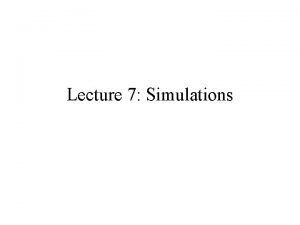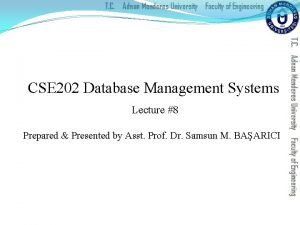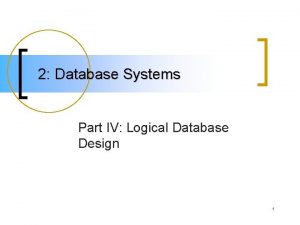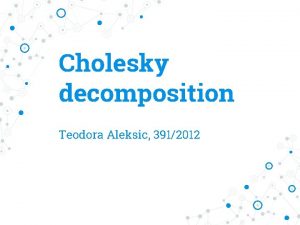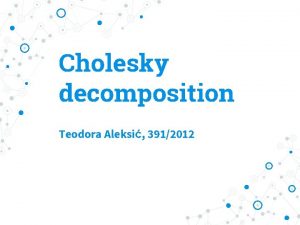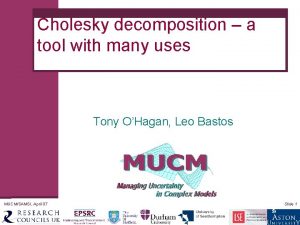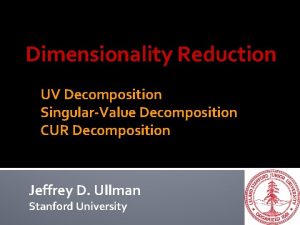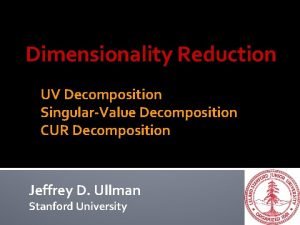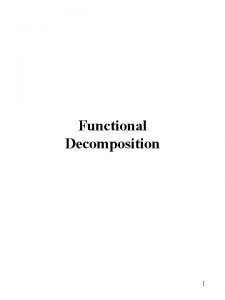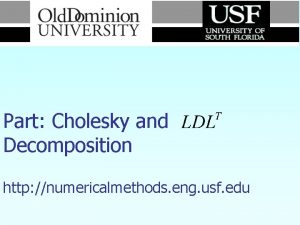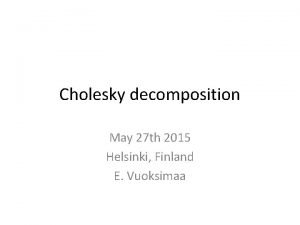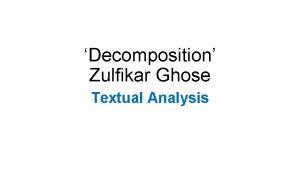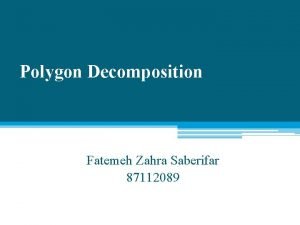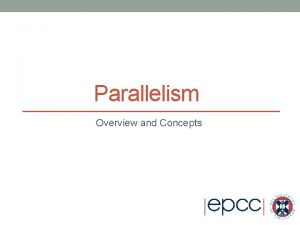Cholesky decomposition a tool with many uses Tony

















- Slides: 17

Cholesky decomposition – a tool with many uses Tony O’Hagan, Leo Bastos MUCM/SAMSI, April 07 Slide 1

Prununciation n Cholesky was French … n Sholesky n But his name is probably Polish … n Kholesky n Or maybe Russian … n Sholesky or n Kholesky or n Tsholesky n Take your pick!! http: //mucm. group. shef. ac. uk Slide 2

Variance decompositions n Given a variance matrix Σ for a random vector X, there exist many matrices C such that Σ = C CT n If C is such a matrix then so is CO for any orthogonal O n Then var(C-1 X) = I n The elements of C-1 X are uncorrelated with unit variance n E. g. n Eigenvalue decomposition C = QΛ½ n Q orthogonal and Λ diagonal n Familiar in principal component analysis n Unique pds square root C = QΛ½QT 2 n Σ = C http: //mucm. group. shef. ac. uk Slide 3

Cholesky decomposition n The Cholesky decomposition corresponds to the unique lower triangular matrix C n Which I’ll write as L to emphasise it’s lower triangular n Partition Σ and L as n Then n L 11 T = Σ 11 , L 22 T = Σ 22. 1 = Σ 22 – Σ 21Σ 11 -1Σ 21 T n L-1 is also lower triangular n Therefore n The first p elements of L-1 X decompose the variance matrix of the first p elements of X n Remaining elements decompose the residual variance of the remaining elements of X conditional on the first p http: //mucm. group. shef. ac. uk Slide 4

Computing Cholesky n Recursion; take p = 1 n L 11 = √(Σ 11) (scalar) n L 21 = Σ 21/L 21 (column vector divided by scalar) n L 22 is the Cholesky decomposition of Σ 22. 1 n Inverse matrix is usually computed in the same recursion n Much faster and more accurate than eigenvalue computation n Method of choice for inverting pds matrices http: //mucm. group. shef. ac. uk Slide 5

Principal Cholesky n There are many Cholesky decompositions n Permute the variables in X n Obviously gives different decomposition n Principal Cholesky decomposition (PCD) n At each step in recursion, permute to bring the largest diagonal element of Σ (or Σ 22. 1) to the first element n Analogous to principal components n First Cholesky component is the element of X with largest variance n Second is a linear combination of the first with the element with largest variance given the first n And so on http: //mucm. group. shef. ac. uk Slide 6

Numerical stability n Important when decomposing or inverting near- singular matrices n n A problem that arises routinely with Gaussian process methods I’ve been using PCD for this purpose for about 20 years n Division by √(Σ 11) is the major cause of instability n Rounding error magnified n Rounding error can even cause √(Σ 11) to be –ve n PCD postpones this problem to late stages of the recursion n n The whole of Σ 22. 1 is then small, and we can truncate Analogous to not using all the principal components http: //mucm. group. shef. ac. uk Slide 7

Fitting emulators n A key step in the fitting process is inverting the matrix A of covariances between the design points n Typically needs to be done many times n Problems arise when points are close together relative to correlation length parameters n n n A becomes ill-conditioned n E. g. points on trajectory of a dynamic model n Or in Herbie’s optimisation PCD allows us to identify redundant design points Simply discard them n But it’s important to check fit n Observed function values at discarded points should be consistent with the (narrow) prediction bounds given included points http: //mucm. group. shef. ac. uk Slide 8

Validating emulators n Having fitted the emulator, we test its predictions against new model runs n We can look at standardised residuals for individual predicted points n But these are correlated n Mahalanobis distance to test the whole set D = (y – m)TV-1(y – m) n n Where y is new data, m is mean vector and V is predictive variance matrix Approx χ2 with df equal to number of new points n Any decomposition of V decomposes D n Eigenvalues useful but may be hard to interpret http: //mucm. group. shef. ac. uk Slide 9

Validating emulators (2) n PCD keeps the focus on individual points, but conditions them on other points Initially picks up essentially independent points n Interest in later points, where variance is reduced conditional on other points n In principle, points with the smallest conditional variances may provide most stringent tests n n But may be badly affected by rounding error http: //mucm. group. shef. ac. uk Slide 10

Example Nilson-Kuusk Model Analysis by Leo Bastos 5 inputs, 150 training runs 100 validation runs D = 1217. 9 http: //mucm. group. shef. ac. uk Slide 11

Example (cont) Plots of PCD components against each of the 5 inputs http: //mucm. group. shef. ac. uk Slide 12

Functional outputs n Various people have used principal components to do dimension reduction on functional or highly multivariate outputs n PCD selects instead a subset of points on the function (or individual outputs) Could save time if not all outputs are needed n Or save observations when calibrating n Helps with interpretation n Facilitates eliciting prior knowledge n http: //mucm. group. shef. ac. uk Slide 13

Design n Given a set of candidate design points, PCD picks ones with highest variances n Strategy already widely advocated Fourcome corners Next first. centres of the The next 12 sides. points fill in Then centre. a 5 x 5 Then thegrid. four blue points http: //mucm. group. shef. ac. uk Slide 14

Design (2) n However, an alternative is to pick points that most reduce uncertainty in remaining points n At each step of the recursion, choose point that maximises L 11 + L 21 T/L 11 First in the 4 Next point we get the. The centre. next 12 green points are all over (notice first loss Then 4 points the place, but of symmetry). around it. still largely The four blue avoid the points are a central area. surprise! http: //mucm. group. shef. ac. uk Slide 15

Design (3) n Consider adding points to an existing latin hypercube design Total variance version again fills space less evenly, but …? http: //mucm. group. shef. ac. uk Slide 16

Conclusion(s) I ♥ Cholesky! http: //mucm. group. shef. ac. uk Slide 17
 Cholesky decomposition excel
Cholesky decomposition excel Hand tools introduction
Hand tools introduction Anvil tool uses
Anvil tool uses Potter's wheel data cleaning tool
Potter's wheel data cleaning tool Wax pattern fabrication
Wax pattern fabrication Many sellers many buyers
Many sellers many buyers E r diagram
E r diagram Convert conceptual model to logical model
Convert conceptual model to logical model Difference between erm and erd
Difference between erm and erd Unary many to many
Unary many to many Contoh erd many to many
Contoh erd many to many Unary many to many
Unary many to many Many to many communication
Many to many communication Sqlbi many to many
Sqlbi many to many Unary many to many
Unary many to many Many sellers and many buyers
Many sellers and many buyers Samuel l jackson mbti
Samuel l jackson mbti Tony devolder
Tony devolder
